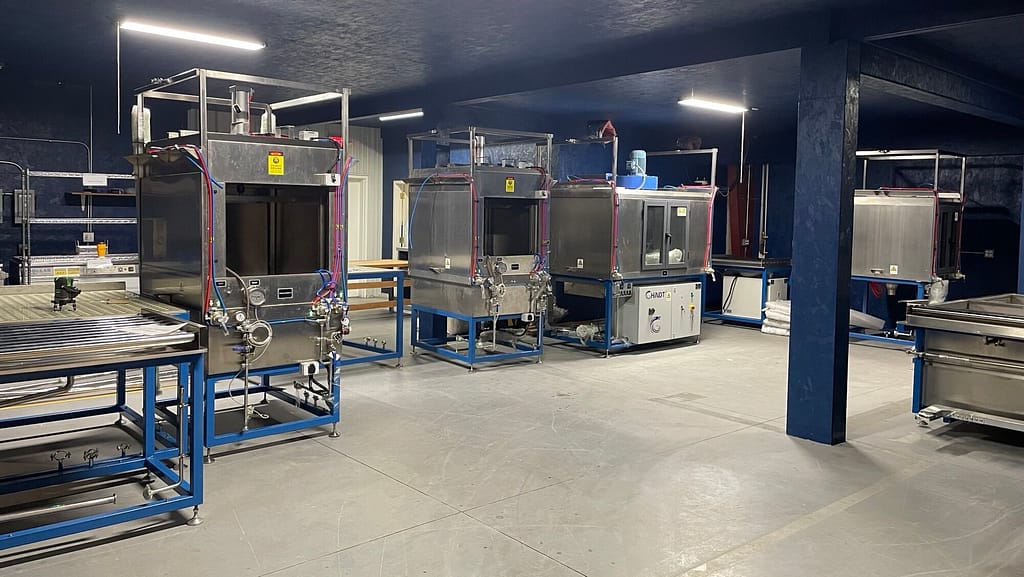Fluorescent Penetrant Inspection Services
There are many ways to inspect parts. Fluorescent penetrant inspection (also known as liquid or dye penetrant inspection) is a form of nondestructive testing designed to detect surface defects on parts without destroying the parts themselves. This assists manufacturers with their quality control, and helps prevent businesses from releasing defective parts into the market.
J&L Dimensional Services has an FPI line dedicated to medical surgical implants. In addition, we're working on an aerospace FPI line that is due to launch in 2022.
Due to the size and speed of our liquid penetrant inspection line, we're able to handle large quantity orders without giving up quality. Contact us to learn more about our fluorescent penetrant inspection services, or request a quote for your project today.
What Defects Does Penetrant Testing Reveal?
During the dye penetrant inspection process, we're on the hunt for discontinuities or interruptions in the normal structure of a part. There are 3 categories of discontinuities: inherent discontinuities, processing discontinuities, and in-service discontinuities. By identifying what kind of discontinuity exists, we can often understand what part of the manufacturing process produced the error. At J&L Dimensional Services, we're equipped to identify both inherent and processing discontinuities with fluorescent penetrant inspection.
Inherent Discontinuities
Inherent Discontinuities are formed during the initial processing, or casting, and solidification process. Types of inherent discontinuities include:
- Inclusions
- Metal Burrs
- Porosity
- Cracks
- Shrinkage
- Hot Tears
- Blowholes
Processing Discontinuities
During hot temperature forming processes like forging and welding, or cold processes like drawing, processing discontinuities sometimes occur. Processing discontinuities include bursts, laps, cracks and more.
How Fluorescent Penetrant Inspection Works
Fluorescent penetrant inspection is a seven-step process. Each dye or liquid penetrant inspection line involves these steps: penetration, dwelling, rinsing, drying, developing, dwelling, and the final inspection.
J&L's Fluorescent Penetrant Inspection Lines
Fluorescent penetrant testing (Liquid penetrant testing/dye penetrant testing) is a nondestructive method of finding defects in non-porous materials. Often times, FPI is a critical part of manufacturing lines that need to inspect the integrity of their parts. At J&L Dimensional, we have a distinct FPI line - a small part line for medical FPI. Our second line, an aerospace FPI line, is expected to be active in our plant in 2022.
Small Part FPI Line
Medical - Surgical Implant Testing
Within the medical field, fluorescent, liquid, or dye penetrant inspection is most commonly used for surgical implants. Implanted devices with defects always cause issues in humans, and some of them are limb or life threatening. That's why fluorescent penetrant inspection is a vital part of the implant making process.
Our small part liquid penetrant inspection line is designed especially for medical applications. Due to the health risks associated with faulty surgical implants, choosing a quality fluorescent penetrant inspection line is crucial for surgical implant manufactures. This line is equipped to do quality inspections for a large quantity of parts.

Multi-Industry LPI Line
Our new multi-industry liquid penetrant inspection line provides for both small and large part processing and facilitates multi-penetrant sensitivity capability. Using only materials qualified in accordance with AMS 2644, J&L regularly inspects current standard(s) including but not limited to, ASTM-E1417, ASTM E165/E165M, ASTM-E433. Having a combined 40+ years of inspection experience and a designated level III inspector on-site, you can trust J&L with your LPI needs.
When You Shouldn't Use Fluorescent Penetrant Testing
FPI isn’t the best solution for every application. If the material you’re inspecting has a rough or porous surface, it’s not a good candidate for FPI. That’s because penetrant will stick in the penetrant will hold in the rough surface and create a false indication.
If we tried to FPI parts that were meant to be rough or porous, the part would glow all over and we wouldn’t be able to get an accurate reading.
Additionally, FPI isn’t for detecting interior defects. So, if you need to inspect the integrity of a part below its surface, it’s best to use X-ray or CT scanning.
Case Study
Finding Flaws and Fixing Parts on our Medical Fluorescent Penetrant Inspection Line
This year, one client wanted to use nondestructive penetrant testing to inspect medical devices. Our team was able to use fluorescent liquid penetrant to discover any discontinuities on the surface of the parts. The feedback we were able to give helped them adjust their process in order to make their parts more accurately. Not only were we able to identify the errors, we were also able to correct some of them. Many of our FPI inspectors are also trained finishers so we were able to salvage the parts in house, re-inspect, and certify them without causing lengthy delays for our customer!
Helping Manufacturers with Limited Capacity Inspect Their Parts
Some of the region’s best manufactures have limited building space that can’t accommodate the size of a proper liquid penetrant testing station. Our team comes alongside those businesses and handles their penetrant testing for them so they can use their space for the manufacturing that they do best.

